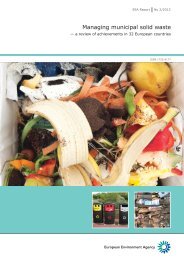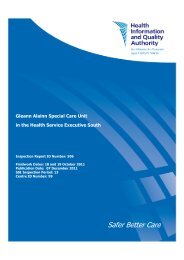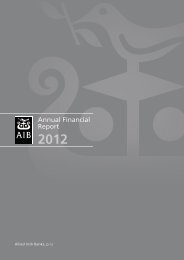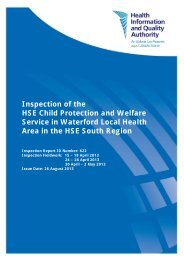HSE Child Protection and Welfare Service in Carlow/Kilkenny - hiqa.ie
HSE Child Protection and Welfare Service in Carlow/Kilkenny - hiqa.ie
HSE Child Protection and Welfare Service in Carlow/Kilkenny - hiqa.ie
You also want an ePaper? Increase the reach of your titles
YUMPU automatically turns print PDFs into web optimized ePapers that Google loves.
Inspection of the <strong>HSE</strong> <strong>Child</strong> <strong>Protection</strong> <strong>and</strong> <strong>Welfare</strong> <strong>Service</strong> <strong>in</strong> <strong>Carlow</strong>/<strong>Kilkenny</strong> Local Health Area <strong>in</strong> the<strong>HSE</strong> South RegionHealth Information <strong>and</strong> Quality AuthoritySt<strong>and</strong>ard 2:4 – <strong>Child</strong>ren <strong>and</strong> famil<strong>ie</strong>s have timely access to child protection<strong>and</strong> welfare services that support the family <strong>and</strong> protect the childThis st<strong>and</strong>ard was met <strong>in</strong> part.There was no formal model of service to respond to the needs of children <strong>and</strong>famil<strong>ie</strong>s. The delivery of child <strong>and</strong> family services were provided <strong>in</strong> a number ofways, through a range of sett<strong>in</strong>gs <strong>in</strong>clud<strong>in</strong>g family support, community development<strong>and</strong> after-school projects, school, youth <strong>and</strong> community sett<strong>in</strong>gs, <strong>and</strong> direct<strong>in</strong>tervention by the social work department. Some of these services were provided tochildren <strong>and</strong> famil<strong>ie</strong>s by community <strong>and</strong> voluntary groups <strong>in</strong> the LHA. These serviceswere procured by the <strong>HSE</strong> through service level agreements, <strong>in</strong> an attempt to specifythe exact services to be delivered. The regional services director showed <strong>in</strong>spectorsthe proposed national model for service delivery. However, this had not beenimplemented <strong>and</strong> was not the model <strong>in</strong> current use <strong>in</strong> the region; social workers onthe ground were not aware of it.Inspectors found that social workers had a good underst<strong>and</strong><strong>in</strong>g of the need for theLHA to <strong>in</strong>tervene early <strong>and</strong> provide a crisis management response to children <strong>and</strong>famil<strong>ie</strong>s. They were able to describe some of the services to which children <strong>and</strong>famil<strong>ie</strong>s had access but social workers themselves were unable to describe theservice delivery model. Furthermore, social workers <strong>in</strong>formed the <strong>in</strong>spectors that theLHA did not have a central directory of available services. They said <strong>in</strong>dividual staffmembers developed their own <strong>in</strong>dividual contact list of services. Social workers told<strong>in</strong>spectors that one of the local voluntary organisations had developed a directory ofservices for the general public which some social workers used. This meant that staffmembers might not always be aware of all resources available <strong>in</strong> the LHA to bestmeet the needs of children <strong>and</strong> famil<strong>ie</strong>s.Early <strong>in</strong>tervention services were effective but referrals were not made <strong>in</strong> a timelymanner <strong>and</strong> some services had more capacity than was used. Where early<strong>in</strong>terventions took place, children, parents <strong>and</strong> carers told <strong>in</strong>spectors that these<strong>in</strong>terventions were effective <strong>and</strong> resulted <strong>in</strong> positive outcomes for them. <strong>Child</strong> careleaders undertook direct work with parents to enhance parent<strong>in</strong>g skills as part of awider approach to ma<strong>in</strong>ta<strong>in</strong> children with<strong>in</strong> the home environment. Community <strong>and</strong>voluntary groups addressed welfare concerns with parents to prevent more complexproblems develop<strong>in</strong>g. Early <strong>in</strong>tervention programmes were also provided by familysupport services from with<strong>in</strong> the social work department. LHA community child careleaders <strong>and</strong> family support workers engaged directly with children <strong>and</strong> famil<strong>ie</strong>s toexplore <strong>and</strong> resolve areas of difficulty. Inspectors were told by two parents that thefamily support worker played a significant role <strong>in</strong> support<strong>in</strong>g them dur<strong>in</strong>g difficulttimes. For example, one family support worker supported a parent to send theirchildren out to school each day. The support workers provided advice <strong>and</strong> directionaround practical issues <strong>in</strong>clud<strong>in</strong>g budget<strong>in</strong>g <strong>and</strong> rout<strong>in</strong>es. Parents told <strong>in</strong>spectors thatwithout this level of support, there was a genu<strong>in</strong>e risk that they would be unable tocope <strong>and</strong> as a consequence the children would be placed <strong>in</strong> foster care.21















